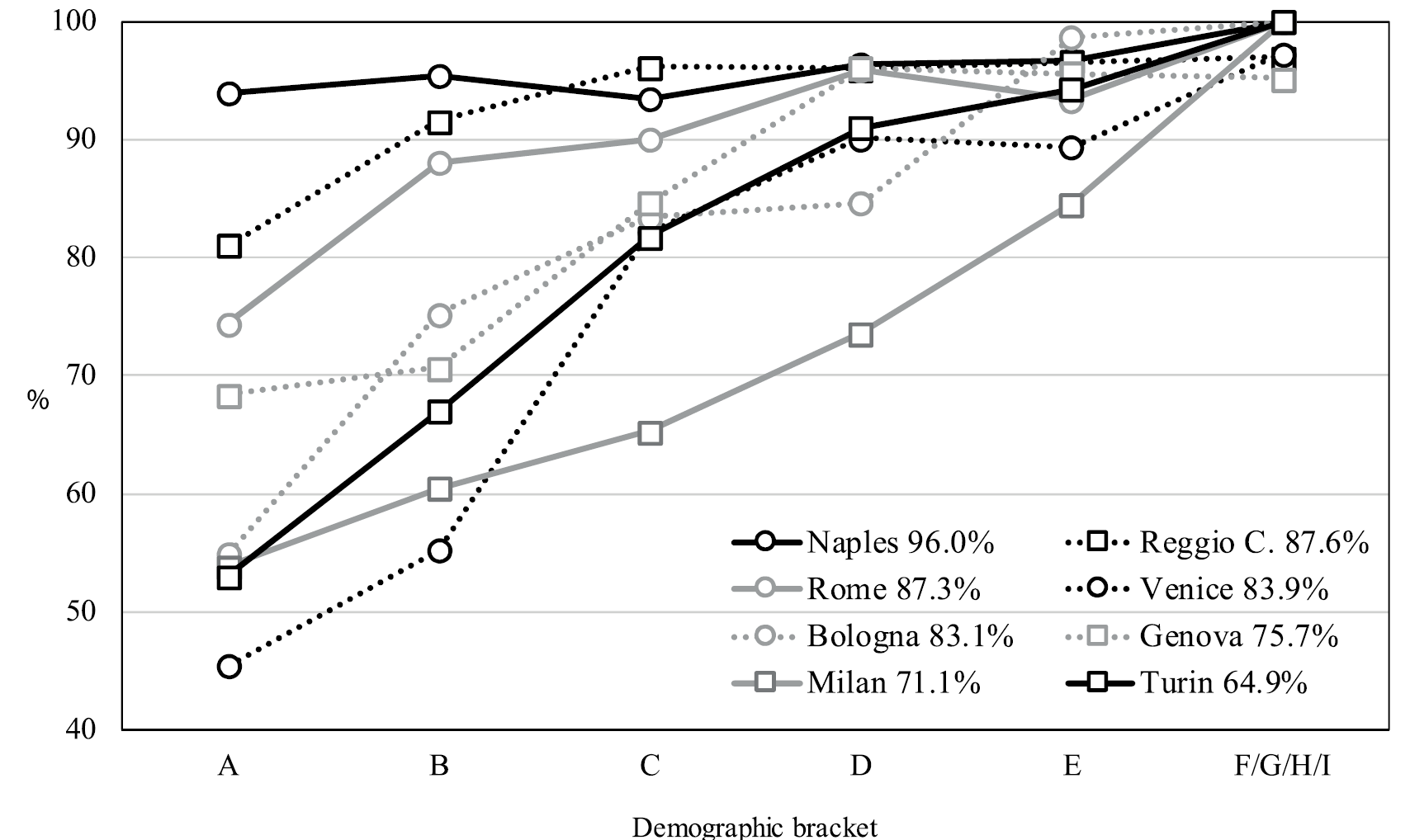“Weighed, not counted”: territorial (mis)representation in Italian metropolitan council elections

Published 2024-01-01
Keywords
- Metropolitan Council Elections,
- Electoral System,
- Territorial Representation,
- Demographic Vote-Weighting,
- Square-Root Vote-Weighting
How to Cite
Copyright (c) 2023 Giancarlo Gasperoni

This work is licensed under a Creative Commons Attribution 4.0 International License.
Abstract
Metropolitan cities were established by Italian Law no. 56/2014 (commonly known as the “Delrio Law”) as a new level of government, replacing and redefining functions previously performed by provinces in selected major urban areas. One of their three key governing bodies is the metropolitan council, a representative assembly the members of which are elected via an indirect, second-level, proportional, list-based system in which the electorate comprises all sitting mayors and councillors from metropolitan city municipalities. The election mechanism applies a differential weighting scheme that reflects the population size of the municipalities in which voters serve as mayors or councillors. Using the outcomes of the metropolitan council elections held in the years 2021 and 2022 in eight metropolitan cities, this study highlights the variety of ways (many of which appear to be largely unintended) in which demographic weighting bestows significantly greater (and, arguably, unwarranted) power to larger cities’ representatives, essentially disrupting the principles of territorial representation that the weighting scheme intended to embody. The study also focuses on how the legal framework for metropolitan council elections generates institutional instability via mandatory forfeitures and ensuing substitutions of seat vacancies. Finally, the author identifies potential adjustments to the electoral system – especially a proposal for the attenuation of disproportionate territorial representation via demographic weighting based on the so-called “square-root method”.
References
- Baccetti, C. (2014). Il capro espiatorio. La Provincia nell’evoluzione del sistema politico italiano. Istituzioni del Federalismo, 34(1): 285-317.
- Banzhaf, J.F. (1965). Weighted Voting Doesn’t Work: A Mathematical Analysis. Rutgers Law Review, 19(2): 317–343.
- Beramendi, P., Boix, C., Guinjoan, M. & Rogers, M. (2022). «Distorted Democracies». Sol Price School of Public Policy working paper: priceschool.usc.edu/wp-content/uploads/2008/08/Rogers_DemocracyDistorted_USCPIPE.pdf.
- Bolgherini, S., Lippi, A. & Maset, S. (2016). In mezzo al guado. La governance subregionale tra vecchie province e nuove aree vaste. Rivista Italiana di Politiche Pubbliche, 11(3): 341-372.
- Bull, M. (2017). Dal referendum costituzionale alle dimissioni di Renzi», in Chiaramonte, A. & Wilson, A. (Eds.), Politica in Italia. I fatti dell’anno e le interpretazioni. Edizione 2017 (pp. 143-166). Bologna: Il Mulino.
- Bussu, S. & Galanti, M.T. (2015). I governi locali al tempo della crisi, in Hanretty, C. & Profeti, S. (Eds.), Politica in Italia. I fatti dell’anno e le interpretazioni. Edizione 2015 (pp. 155-173). Bologna: Il Mulino.
- Caporale, M. (2017). Parità di genere e organi assembleari di città metropolitane e province dopo la Legge Delrio, in Murgia, A. & Poggio, B. (Eds.), Saperi di genere. Prospettive interdisciplinari su formazione, università, lavoro, politiche e movimenti sociali (pp. 594-609). Trento: Università di Trento.
- Caporale, M. & Gasperoni, G. (2016). Elezioni dei Consigli metropolitani. Caratteristiche, esiti e nodi critici emersi in occasione del voto del 9 ottobre 2016. Istituzioni del Federalismo, 37(4): 1035-1067.
- Coleman, J.S. (1971). Control of Collectives and the Power of a Collectivity to Act, in Lieberman, B. (Ed.), Social Choice (pp. 192-225), New York, Gordon and Breach.
- De Donno, M. (2022). La sentenza della Corte costituzionale n. 240 del 2021 e la legge Delrio: quale futuro per gli enti di area vasta? federalismi.it, 3: 92-113.
- Economist, The (2021). The mathematical method that could offer a fairer way to vote. The Economist, December 18-31 issue.
- Forte, P. (2014). Il percorso costitutivo delle città metropolitane: nascita di un ente territoriale. Istituzioni del Federalismo, 34 (1): 333-359.
- Fusaro, C. (2017). L’ennesima riforma costituzionale fallita, in Chiaramonte, A. & Wilson, A. (Eds.), Politica in Italia. I fatti dell’anno e le interpretazioni. Edizione 2017 (pp. 123-142). Bologna, Il Mulino.
- Gasperoni, G. & Caporale, M. (2021). Cinque anni dopo. La disfunzionalità del sistema elettorale e la debole efficacia rappresentativa dei Consigli Metropolitani. federalismi.it, 26: 85-143.
- Penrose, L.S. (1946). The Elementary Statistics of Majority Voting. Journal of the Royal Statistical Society, 109(1): 53-57.
- Peters, B.G. (2018). Institutions and Voting Behavior, in Fisher, J., Fieldhouse, E., Franklin, M.N., Gibson, R., Cantijoch, M. & Wlezien, C. (Eds.), The Routledge Handbook of Elections, Voting Behavior and Public Opinion (pp. 41-53). New York, Routledge.
- Ratzer, E. (2006). On the “Jagiellonian Compromise” – Voting in the European Union, Cambridge, University of Cambridge (www.inference.org.uk/ear23/voting/voting.pdf).
- Słomczyński, W. & Życzkowski, K. (2006). Penrose Voting System and Optimal Quota. Acta Physica Polonica B, 37(11): 3133-3143.
- Życzkowski, K. & Słomczyński, W. (2004). Voting in the European Union: The Square-root System of Penrose and a Critical Point. ArXiv (doi.org/10.48550/arXiv.cond-mat/0405396).

